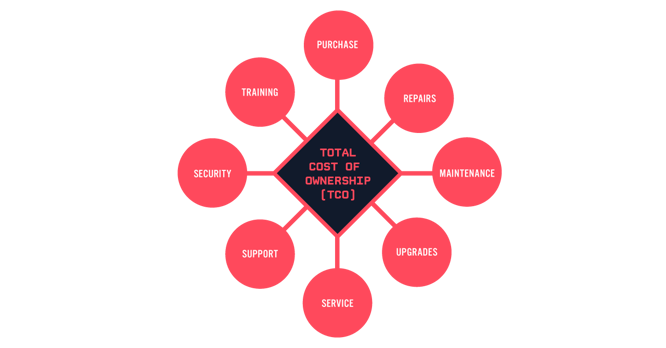The buy vs. build software decision is one of the most important decisions your enterprise will make as you approach an IoT implementation. Your development team may be multi-talented. Your leadership team believes it can be done. But, for organizations using IoT to deliver assets to the marketplace, there is a significant difference in the set of skills, investment, and time required.
Generally, a buy vs. build software decision relies on the following factors:
- Strategic direction
- Time to market
- Team resources
- Maintenance
- Customization needs
An IoT solution requires a platform with an architecture to support a combination of hardware, software, networking, customer interfacing, and data management. An IoT platform serves as the foundation for applications and must orchestrate many moving parts. 
So how can you decide if your team should design, build, test, and manage its own IoT platform, or purchase a license to a software service? Without careful analysis, it may seem that building in-house is more affordable, but there are a number of factors to consider:
- Is your team equipped to build a secure, scalable architecture sustainable enough for present and future use cases?
- Will your team be able to monitor the platform and provide post-development support?
- Is your enterprise prepared to develop working interfaces for teams and customers?
- Can you source the members of a capable team with IoT expertise and skills for every part of the stack?
- Will the ROI for building in-house be more or less than the total cost of ownership (TCO)?
What Is the Total Cost of Ownership for IoT
The total cost of ownership is a financial estimate used to calculate the direct and indirect costs of a product or system. For an IoT solution, a TCO estimate includes the initial implementation costs and all costs incurred by the asset during its life of service. This could include but is not limited to devices, data storage, data transfers/messages, software, hardware, labor, repairs, security auditing, monitoring, and support. The long-term total cost of ownership is significantly higher by going the build route. When building a platform, all of those costs will be assumed by the enterprise, however, when licensing a platform you will have a lower TCO. Many of the considerations are included as a part of the license. A common consideration for enterprises to make is how the TCO affects the potential ROI.

Calculating Time and Cost
Of course, the requirements of your IoT solution and the time it takes to build an IoT application will depend on the business problem you are trying to solve or the product you are trying to develop. Platform buyers who are considering a long-term strategy may consider buying a robust, extensible platform like Losant. If the problem is very specific, other buyers may consider buying a vertical application. Certainly, you should let the data drive the decision. Indeema has created a valuable IoT project calculator to realistically identify the amount of time it takes to build an IoT application. MachNation also has a TCO calculator to help enterprises understand the total cost of building an enterprise-grade application enablement platform as well based on a five-year timeline.
As you consider the time and cost investment required, also consider how getting the foundation of IoT architecture provided for you could save your team significant development time. According to McKinsey, IoT leaders have found success by relying on external partners for IoT expertise. This enables the internal team to instead focus on the current business problems and initiatives.
"Building internally usually is more costly than buying externally. This is especially true with IoT because of the expertise needed to build a scalable solution."
Charlie Key, Losant CEO
The truth is that even if your enterprise subscribes to a cloud service in an effort to build IoT applications, some configuration will be required. The question should instead be, how can you streamline IoT application development work for your team?
Streamlining IoT Application Development
What does it take to streamline IoT application development? According to the analysts at MachNation, using an IoT application enablement platform (AEP) is 40 percent less expensive than building and maintaining an in-house solution. Not to mention, some of the most popular cloud vendor services including MS Azure, AWS, GCP, and IBM each offer a large catalog of independent services, but the gap between these disparate services and a delivered IoT solution can be difficult and expensive.

As mentioned before, even a cloud service purchase will require some configuration. It requires the construction of architecture for IoT-specific applications and writing code, versus having some of that foundation already built for your organization with an AEP. Beginning with or layering in an application enablement platform like Losant can enable your team to streamline development to achieve strategic business goals, and build market-ready IoT solutions.
"With Losant, you can focus on creating an IoT solution that delivers value for your business without having to spend time and energy on the nuts and bolts of things like maintaining and scaling infrastructure."
Michael Kuehl, Losant CTO
Select the Appropriate IoT Path for Your Environment
Are you looking for additional resources to help you make your build vs. buy decision? MachNation developers executed an identical IoT proof of concept in Losant and Azure to evaluate each platform’s capabilities. Overall, it took MachNation’s developers 30 hours to build a complete IoT edge PoC with Losant. If developers were able to complete the project, it would have taken 74-94 hours to implement the same edge PoC on Microsoft Azure. If you are looking to streamline IoT application development for your team, speak with one of our IoT experts about how the Losant application enablement platform can help you realize your IoT vision.
